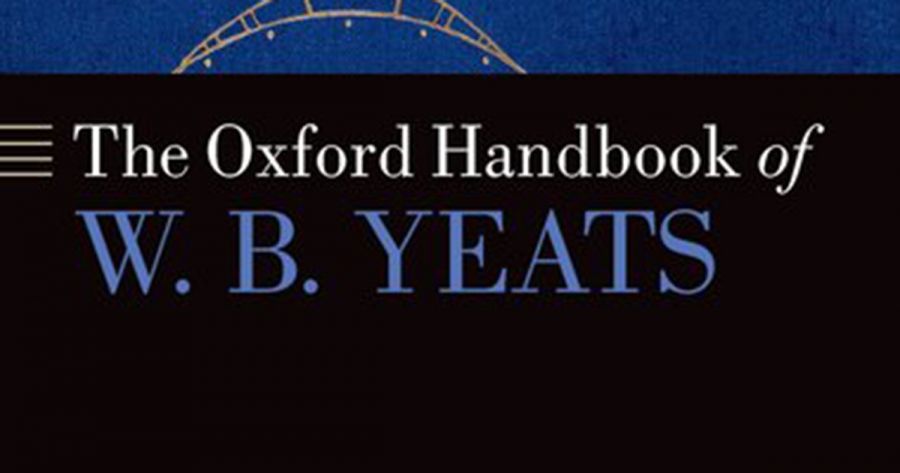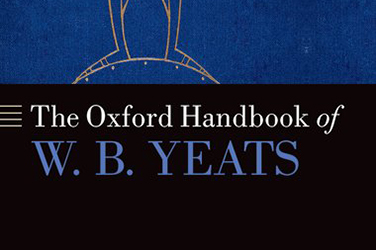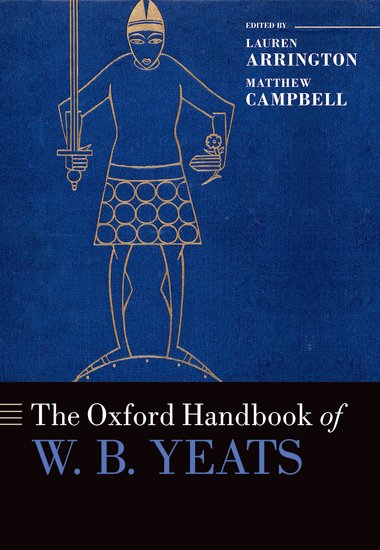
- Free Article: No
- Contents Category: Literary Studies
- Review Article: Yes
- Article Title: Inexhaustibly generative
- Article Subtitle: Exploring an efflorescence of Yeatsian activity
- Online Only: No
- Custom Highlight Text:
What then? sang Plato’s ghost.’ Editors Lauren Arrington and Matthew Campbell begin their Preface to the massive Oxford Handbook of W.B. Yeats with the poet’s own injunction to old age. And what a life it was: seventy-three years lived over two world wars; a mammoth literary oeuvre criss-crossing Victorian melancholy, Romantic sublimity, and Modernist apocalypse. At different times and sometimes simultaneously, Yeats was a bohemian raconteur in the Cheshire Cheese pub, a radical nationalist leader of the Irish Revival, a cosmopolitan disciple of the occult, and a waspish senator enraged by the philistinism of the Irish Free State.
- Featured Image (400px * 250px):

- Alt Tag (Featured Image): Jeremy George reviews 'The Oxford Handbook of W.B. Yeats', edited by Lauren Arrington and Matthew Campbell
- Book 1 Title: The Oxford Handbook of W.B. Yeats
- Book 1 Biblio: Oxford University Press £135 hb, 752 pp
- Book 1 Cover Small (400 x 600):

- Book 1 Cover (800 x 1200):

First is the fact that Yeats studies arguably reached an emotional and intellectual crescendo in 1980s, when something called Irish Studies emerged. The sectarian violence of the Northern Irish Troubles had encouraged the notion that Ireland was wracked by an unprecedented identity crisis. Into this context strode young and polemical nationalist literary critics steeped in the new disciplines of cultural studies and continental theory to clash in print with historians they pejoratively dubbed ‘revisionist’. At stake in these skirmishes was whether Irish literature, history, and indeed Irish society itself should be analysed through the postcolonial paradigms established in the wake of mass decolonisation movements following World War II, or whether this was a historically inaccurate imposition designed to provoke unnecessary sectarianism. Culturally othered but constitutionally British since the 1800 Act of Union, pre-1922 Ireland could never be placed comfortably. Yeats’s own contradictions as the national poet – an Anglo-Irish nationalist with aristocratic pretensions – were exemplary of the debate, and both sides were keen to claim him to prove their point. Yeats’s resistance to categorisation – the ‘man and his masks’, to quote the title of Ellman’s 1948 study – further allowed him to become an unlikely lightning rod for new poststructualist currents in comparative literature, which stressed the importance of ideas like hybridity, alterity and mimicry. Edward Said, Terry Eagleton, and Frederic Jameson produced influential pamphlets on Yeats for the Derry-based Field Day, and Colombia star Gayatri Chakravorty Spivak lectured on his poetry and Derridean deconstruction at the 1963 Yeats Summer School in Sligo. The postcolonial reading of Irish literature, though not monolithic, soon became almost shorthand for Irish Studies itself. The pronouncements of some of its new disciples, lacking the verve and vigour of the previous generation, but full of what Yeats dubbed ‘passionate intensity’, provoked the feeling that a radical intervention had become a critical orthodoxy, particularly after the Good Friday agreement officially ended the Troubles in 1998. At the turn of the millennium, it seemed that Irish Studies might be slowing down.
In 1999, Pascale Casanova’s The World Republic of Letters appeared. It announced the arrival of a new model for literary studies, a revitalisation of Goethe’s concept of ‘World Literature’. If philosophically informed comparativists had burrowed deep into the literary text, those involved in the new World Literature turned to sociology, zoning out from national borders to see a traversable and continuous global, or even planetary, literary ecosystem. Casanova’s pioneering study placed central importance on what she called ‘The Irish Paradigm’. In many ways. this reclothed, in the harder language of sociology, that quality of ‘liminality’ in Yeats which was so attractive to Poco theorists in the 1980s. Casanova argued that as a literature always caught between the centre and periphery, Irish literature, and specifically Yeats’s fin de siècle Irish Revival, provided a compact history of the transition from nineteenth-century conceptions of local linguistic nationalisms to the global ‘autonomy of literature’ crucial to the consecration of World Literature itself in the twentieth century. Yeats and Irish literature had returned to centre stage, and this time the academic production was even more epic. Providing a relief from the political and identitarian demands of comparative postcolonialism, with a capacious analytical vocabulary drawn from world-systems theory and globalisation studies, World Literature provoked an efflorescence of Yeatsian activity during the first decades of the twenty-first century.
So, Yeats, a central and exemplary figure for the major trends in literary studies for nearly a century, has had a good run. It is as if every critic worth their salt from Derry to Dartmouth has penned something on him. The density of this archive can be a heavy burden. The five-part structure of the Handbook, which, the editors suggest, charts the ‘story of world literature’ but which also seems to be the story of Yeats’s reception in academic literary studies, is impressive for making the outlines of this archive clear without being overwhelmed by the anxiety of influence.
A schematic overview if one were to read the Handbook cover to cover (which I do not recommend) is as follows. Part I offers essentially biographical accounts of Yeats’s family, friends, and collaborators. Part II gives even-handed historicist perspectives with a focus on the political, a kind of neutral account of some of the Yeatsian themes which preoccupied nationalist critics in the 1980s. These essays cover the influence of Yeatsian predecessors (Dante, Shakespeare, Renaissance Italy) as well as more contemporary figures and forces (the Easter Rising, Italian fascism, Charles Parnell). Part III goes full World Literature, with insightful essays on Yeats’s relations with Africa and Iran, and then rockets into the solar system, reaching for the stars (literally) with speculative takes on Yeats and astrology as well as his visionary occult dalliances. Part IV traces Yeats and the media: a clever editorial decision braids analyses of his poetic and technological manipulations together. Part V on theatre studies includes some interesting analysis on movement and performance (particularly Susan Jones on dance), but emblematises one wider problem facing the volume.
Yeats, of course, must be considered alongside contemporary theoretical developments in queer studies, ecocriticism, etc. But in order for this relationship to be productive, presentism must be resisted. It seems an important distinction that there exist terms, problems, and concepts that Yeats can help us think about today, but of which he himself was not explicitly thinking. Zsuzsanna Balázs’s essay on the late plays and transgressive sexuality, for example, has many interesting things to say about the ritualised relations of violence and desire in Yeats’s drama, but because it indexes these observations to an utterly contemporary interpretation of sadomasochism, the argument can at times seem implausible. Part VI considers the expanded scenes in which we read Yeats today, from Anglo-Ireland to the InteLex digital database. Finally, the celebrated poet Vona Groarke provides the collection’s postscript with charming if sometimes-cringey speculative realism, wondering how Yeats would get on in the MFA-dominated literary festival circuit.
‘What then?’ Every contribution in this volume offers some response to this question: as Yeats grows more distant from the forces that shape our present, does his writing, worn out from generations of academic explanation and analysis, become blunted equipment for the task of intellectual thinking? The best essays demonstrate beyond doubt that Yeats remains a sharp knife with which to peel and portion the present. But what strikes me is that if Arrington and Campbell begin the collection by claiming that Yeats’s relevance continues to derive from his status as a figure in the story of World Literature, the most persuasive contributions to this volume start from somewhere much smaller and more concrete. They recognise, perhaps, that studying Yeats in a world marked by political individualism and anthropogenic climate change necessitates returning floating academic paradigms to their strong spine of meaning: literature.
These essays – and I would single out those by Jahan Ramazani, Geraldine Higgins, Adam Gills, and Stephanie Burt – master a kind of Yeatsian double-think for literary criticism. They ground theoretical and historical arguments first in the communal and idiosyncratic spaces produced in form. ‘What then?’ This insightful and wide-ranging volume suggests that those who remain committed to Yeats today should return to those polyrhythmic qualities and sonic rhythms which so richly texture his oeuvre. As the poet said himself, it is the arts which lie dreaming of the things to come.


Comments powered by CComment